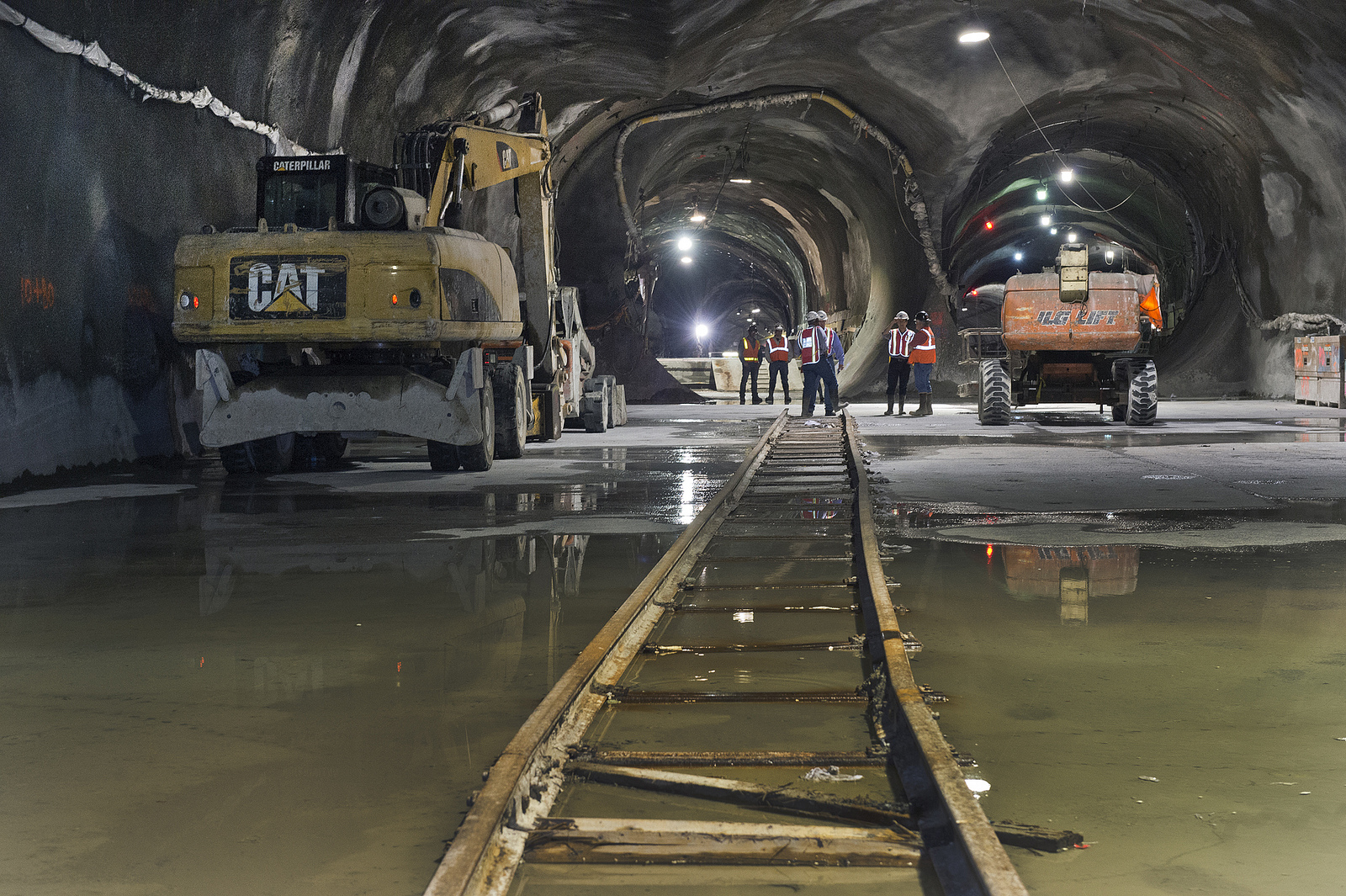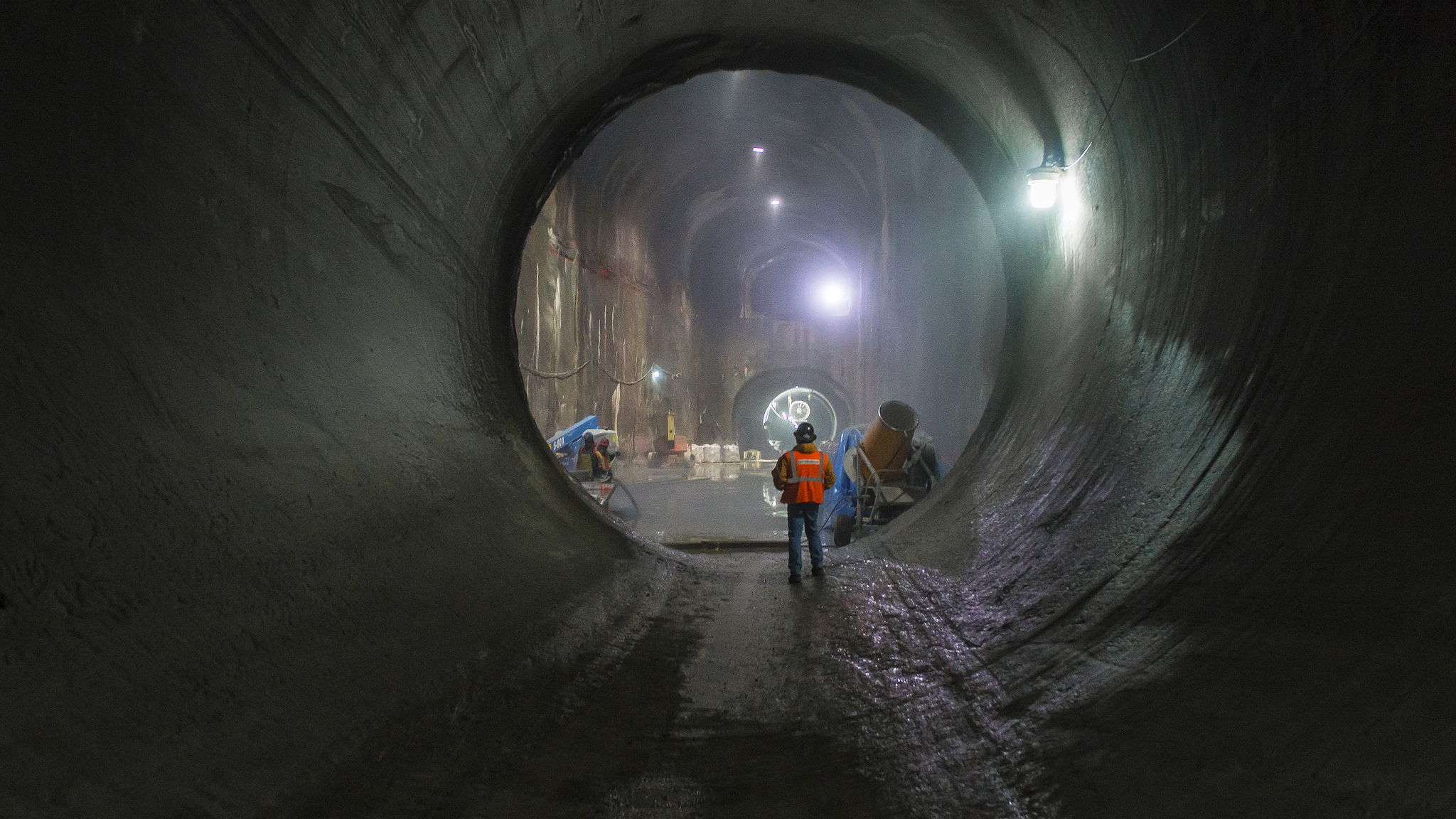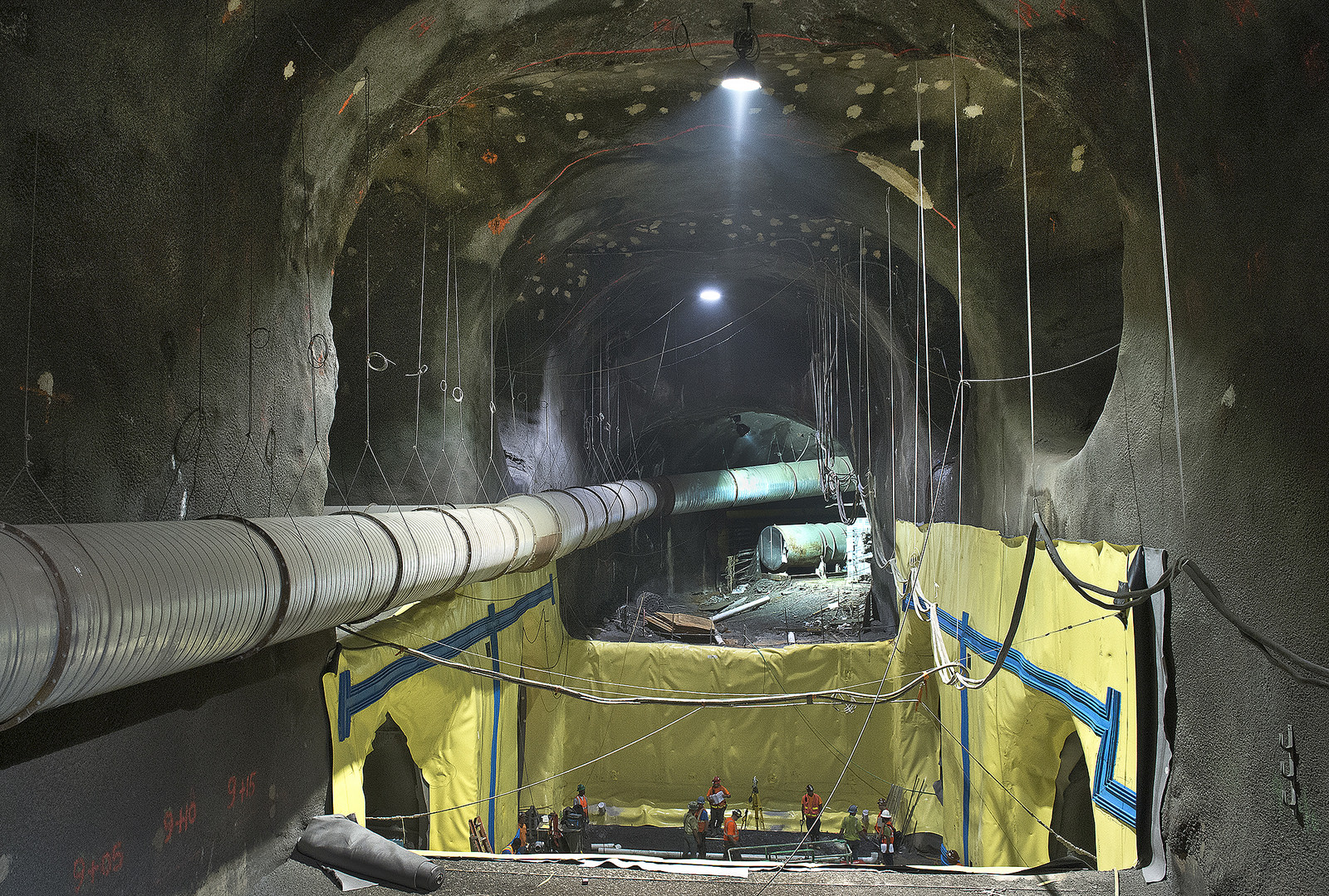by: jchristie
Beneath our feet, water is flowing, electricity is circulating, freight is being hauled, subways are barreling by, and one mile of rock, thousands of feet deep, is being excavated out of Manhattan, carted through Queens to Pennsylvania, to make way for MTA’s East Side Access. The $10.2 billion infrastructure project, slated to open between 2019 and 2022, will connect the Long Island Rail Road (LIRR) to a concourse underneath Grand Central Terminal. When the LIRR connected to Manhattan for the first time in 1910, development on Long Island was flourishing. The engineers, planners, and architects behind the East Side Access are braced for a second transformation. “This changes everything,” said LIRR Chief Planning Officer Elissa Picca. It’s a “time machine,” said MTA Associate Director of Planning Jack Dean, anticipating “unbridled bliss” as hundreds of thousands of Long Islanders commute to work in less time, in smaller crowds, and with fewer operational hiccups.
On 10.06.2014, the minds behind MTA’s East Side Access gathered at the Museum of the City of New York for the sold-out presentation, “A New Terminal Under Grand Central: The East Side Access Project,” co-sponsored by AIANY. With 11 branches and 124 stations, the LIRR currently serves 3.2 million riders annually; every day, 287,000 people ride on 741 different trains. For decades now, the second largest commuter train in the country has been overtaxed, outgrowing Penn Station. East Side Access, originally planned in the 1960s, is the first expansion of the LIRR in more than 100 years. It will alleviate congestion on the train, in Penn Station, and on the 2/3, 7, and E subway lines, and will shorten the commute to the East Side.
MTA boasts that by reducing or eliminating the “second commute” from Penn Station to the East Side, East Side Access will peel away an average of 20 minutes of commuting time each way, accumulating to 40 minutes a day and totaling 20 days a year. While only one third of Long Island commuters ride the LIRR, planners hope that the easier commute will lure drivers to convert to public transportation, as well as make East Midtown, with the densest concentration of jobs in any district in the country, more accessible. With 24 trains arriving to Grand Central every hour on eight tracks, East Side Access will accommodate 160,000 new riders.
Transportation generated the modern city, and with it, the suburbs. While Robert Moses’s highway system shaped what Long Island towns look like today, the LIRR transformed what was a rural and agricultural countryside in the 19th century into a budding suburb in the early 20th Century. Picca anticipates that the new railroad will have a robust ripple effect on the Long Island economy, bringing home more capital from high-paying, East Midtown jobs, boosting property values, enhancing regional competitiveness, encouraging local business (through ease of access), revitalizing downtowns, and increasing the retention rate of Long Island’s greatest resource – its children – who leave in search of vibrant neighborhoods with rental options. (For every rental unit on Long Island, there are 10 occupants.) East Side Access, said Picca, could be a “catalyst for the reimagining of suburbanization.” The highway system, traffic congestion, and sprawl that symbolize much of Long Island form significant obstacles to the transit-oriented development Picca envisions, or a “’post-postwar’ economy,” recent infrastructure additions to the Metro North Railroad and New Jersey Transit have resulted in growth in Westchester and New Jersey, including reverse commuting, particularly in White Plains, and downtown revitalization.
Long Island, unlike other commuter regions, is not only a point of departure, but also a destination for tourists. Commuters will enjoy an easier trip to work, and New Yorkers and other tourists will enjoy greater access to the island’s beaches. Tourism will likely spur development as well as gentrification, an issue that has been the source of frustration for long-time island residents. While offering greater access to New York’s wealth and to the global economy, a stronger connection to New York City will affect Long Island’s regional culture and economy.
Other concerns include congestion in Jamaica, Queens, and adaptation to a new schedule for residents. And, of course, the exorbitant costs. “It’s amazing to me,” said Susan Henshaw Jones, director of MCNY, at the beginning of the program.“Where does $10.2 billion come from?” The evening ended on a similar note with Henshaw Jones commenting: “$10 billion to move 40% of the Long Island Rail Road to the East Side; I can’t help but feel, given how the subway system is struggling, that the project is elitist.” Rather than denying Henshaw Jones claim, the panelists blamed the singularity of the project’s scale on a lack of funding for public transportation. Dean called the MTA’s proposed 2015-2019 $3.2 billion Capital Program a balanced plan aligned with the MTA’s mission to provide a unified network for everyone, yet earlier he stated that East Side Access gained funding, including more than $203 million in federal funds, because the project posed little risk. Coming into a part of the city as rich and dense as East Midtown, East Side Access was one of the most cost-effective projects pitched.
Heading back to the city, East Side Access has major implications for the East Midtown district and Grand Central Terminal. Edith Hsu-Chen, NYC Department of City Planning director for the borough of Manhattan, representing the district on the panel, illustrated how the project benefitted one of New York’s primary business hubs. With 70 million square feet of office space and 250,000 jobs, East Midtown is a financial core of the city and a major tax base. But, as the district has been largely developed for a long time, there is little room for new construction and the office buildings, 75 years old on average, lack modern features attractive to businesses. The district’s key strength, access, is fortified through investments like East Side Access and the Second Avenue subway. To capitalize, in part, on East Side Access, as well as to compete with other emerging business hubs such as the new World Trade Center and Hudson Yards, the district is fighting to change zoning laws, including increasing density on Vanderbilt Avenue from 42nd to 47th Streets. The new zoning laws would create room for the proposed KPF-designed One Vanderbilt, a 65-story tower with 1.5 million square feet of office space and underground access to Grand Central for 65,000 people.
For East Midtown, East Side Access is a platform for expanding and revitalizing its status as a business hub. The design of LIRR’s Grand Central Concourse similarly reflects an expansion of its current state, rather than a transformation. “Connection and continuity,” said Douglas Tilden, MTA program manager for Grand Central Terminal, in describing the extension. “We want people to feel that they are in Grand Central,” said Beyer Blinder Belle’s Frank Prial, Jr., AIA, as he showed renderings of the new terminal, equipped with two-story spaces, shallow arches, marble wall panels, terrazzo floors, and hand-painted, Garamond Bold lettering, as well as similar lighting, handrails, and guardrails. Street indications on nodes throughout the concourse help ground a visitor’s sense of place. Built beneath the food concourse on the lower level of Grand Central, the new, 375,000-square-foot concourse will include 25,000 square feet of retail and four escalators, two of which will bring riders directly up to the Grand Concourse by way of the Biltmore or “kissing” room.
Initially intended to connect New York and Boston, the LIRR today is alien to its original function. While we can assert predictions of East Side Access’s effect on suburban and urban development and the commuter and tourist experience, it is unknown what this new tool will facilitate. Like the railroad that, by diminishing spatial distance, radically changed the structure of our society and built environment, digital technology is revolutionizing how we use space. Hsu-Chen confirmed that office space is, at the moment, as attractive to businesses as ever, but digital technology will likely change the kinds of office space we need, and the kinds of districts in which we “work,” “live,” and “leisure.”
Event: A New Terminal Under Grand Central: The East Side Access Project
Location: The Museum of the City of New York, 10.06.14
Speakers: Frank Prial, Jr., AIA, Beyer Blinder Belle Architects & Planners; Douglas Tilden, Program Manager, Grand Central Terminal, MTA; Jack Dean, Associate Director of Planning, MTA; Elissa Picca, Chief Planning Office, LIRR; Edith Hsu-Chen, Planning Director for Manhattan Borough, NYC Department of City Planning; and Maxinne Leighton, Assoc. AIA, Parsons Brinckerhoff
Organized by: The Museum of the City of New York
Co-sponsored by: AIA New York Chapter











